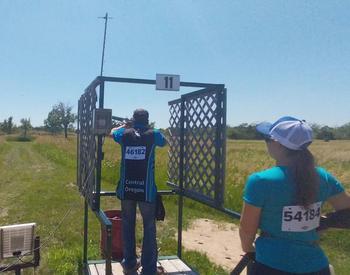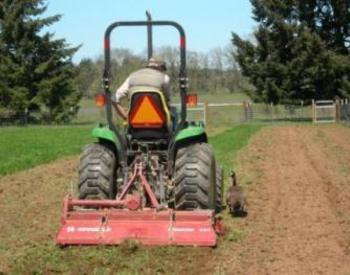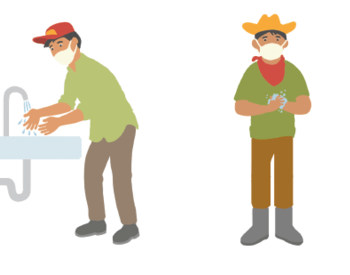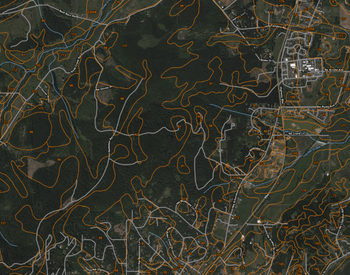Transcript
Hello, my name is Heather Medina, and I work for the Natural Resources Conservation Service here in Tangent, Oregon. I am the Basin Team Leader for the Central Coast Upper Willamette Basin, and my pronouns are she/her and aya. Today, we have a presentation on soil health, and I am here with Cheyenne Rico, who will also be presenting.
My name is Cheyenne Rico, and I'm a Soil Conservationist in the Upper Willamette and South Coast Basin for NRCS Oregon. Today, I'm going to be talking a little bit about soil health followed by a soil health demonstration. The USDA definition of soil health is the continued capacity of the soil to function as a vital living ecosystem that sustains plants, animals, and humans. The key word here is living. There can be more organisms in a single teaspoon of soil than there are humans currently living on planet Earth. We depend on these organisms to grow healthy, abundant crops, which are essential to feed a growing population. Without this life, we essentially just have dirt, which is the mineral component of the soil—sand, silt, and clay. So, simply by eating every day, we all have a very important relationship with the soil and should care about soil health.
NRCS has five soil health principles, which are focused on soil health management because soil health is a dynamic soil property that readily changes and responds to management. These principles are really focused on proliferating the life in the soil. The first principle is maximizing the amount of time that roots are living in the soil throughout the year. Roots not only help physically stabilize the soil, but they are also the lifeline for soil organisms. Plants take in carbon dioxide from the atmosphere through photosynthesis and turn this into sugars, which feed soil organisms. Because of this, we find the most microbial activity directly closest to the roots, known as the rhizosphere. So, by maximizing the amount of time and space you have living roots in the soil, you're really maximizing the food availability for soil organisms, which helps encourage their populations and their function.
The second principle is to keep the soil covered. If you have living roots, they are attached to above-ground biomass, which is helping to keep the soil covered. This can be food crops or cover crops, and you can also use crop residues and mulches, all of which help keep the soil covered and protected from the elements such as heavy rainfall and wind. But it also serves a very important role of keeping the soil moist and conserving soil moisture, which soil organisms need to function just like we do. This is also why synthetic inorganic fertilizers can be detrimental to soil health because they dehydrate soil organisms. So, keeping the soil covered helps conserve soil moisture.
The third principle is to diversify soil biota by diversifying plants. There are many different types of soil organisms—bacteria, protozoa, nematodes, fungi, arthropods, earthworms—and all of these organisms have different nutritional needs and dietary preferences. By diversifying the plants you have in the soil, you're diversifying the root exudates, diversifying the food source, and this is ensuring that everyone gets fed, and you have a diverse array of soil organisms because bacteria actually don't release the nutrients that they obtain from breaking down soil organic matter and minerals. They actually need predators to eat the bacteria, which then helps the nutrient cycling.
The fourth principle is to minimize disturbance. So, if you're following the other three soil health principles, you have living roots, you have the soil covered, and a diversity of plants, maybe different crop rotations. By disturbing the soil through tillage, for example, you're really setting all of that back. You are killing roots, you're breaking up the soil aggregates, destroying soil habitat, and you're also oxidizing carbon and nitrogen that's stored in the soil, which goes into the atmosphere. So, minimizing disturbance really helps maintain the integrity of the other soil health principles.
The last one is livestock integration, which is another tool to help maintain the integrity of the soil. Livestock can help with crop residue management, for example, cover crop termination, which helps minimize soil disturbance and facilitate a no-till system. Livestock also help bring in nutrients back into the soil, such as carbon and nitrogen.
We are going to do a soil health demonstration looking at aggregate stability. We have four different soils with different management practices, and some have more soil health principles than others. The first demonstration that we're going to do is with a silty loam that's collected from the same farm. This farm is organic, and what they like to do is rotate heavy-feeding, medium, and low-feeding crops, followed with a cover crop. We have what they considered maybe their lowest productive soil because it's in the low-feeder stage. It's already had the high-feeding crops, medium-feeding crops, and it's ready to be planted to a low-feeding crop and was just recently tilled with a walk-behind rototiller. And then we're going to compare that to another plot that they had that was currently planted with buckwheat cover crop.
Okay, we have our two different soils, different management. One thing you'll notice with these soils is the buckwheat cover crop is a little bit darker in color than the low-feeding bed that is ready for carrots. The buckwheat cover crop soil, having that darker color, is an indication that it has a higher amount of organic matter. If you could see this up close, you would also see that the buckwheat cover crop soil also has quite a bit of roots. So, we're going to drop this in the water, and we're going to see how stable these aggregates are. Aggregate stability is an indicator of soil health. But what's happening here is these are air-dried soils, and when they were dropped into the water, the air that's inside and all those pore spaces is being pushed out by the water. So, there's a pressure and a force that's being exerted on the soil aggregates, and whether or not these aggregates can kind of withstand to that force is a good indicator of soil health and how well it will hold up to being saturated during heavy rainfall. Because if it doesn't hold together very well, that's when you get erosion, and you can get silt and clay particles filling in the macropores, which leads to compaction over time and poor infiltration. And you don't want that because we want infiltration, of course, in the soil to keep it moist and to water our crops. But also, when you have soil compaction and then you have a high rainfall event, that's when you get a lot of soil eroding away, which can end with sediments and nutrients transported to surface and groundwater. Both of these soils have particles that have kind of slaked off. If you can zoom in, or at least from my angle, the buckwheat cover crop has fewer particles on the bottom of the jar, so it's holding together a little bit better, which can probably be attributed to the soil organic matter.
Now we're going to compare kind of two different extremes. We have a soil that was collected between two rows of crops that is tilled just for weed suppression, so it's continually tilled at least once a year for weed suppression but doesn't ever have anything growing in it. And then we have an uncult
ivated soil that has not had any disturbance. It's currently in grass. What you'll see when we zoom in on these soils is that the uncultivated soil visibly has a coating of fungal mycelium. So, that is really going to help keep the soil together as the mycelium holds the soil particles together and also produces extracellular compounds that serve as essentially soil glue. So, you can see that the tilled soil is readily and rapidly just disintegrating. You have all those silt and clay particles that will not hold together during saturation during heavy rainfall, and then they're going to be filling in those macropores, essentially suffocating the soil, can lead to surface crusting and compaction over time, poor infiltration rates. Meanwhile, the uncultivated soil is holding together very well. I don't actually see any particles really that are falling off. That mycelium is especially just holding those particles together really well. So, that's a very stable soil aggregate, which is a good indicator of soil health.
From an economic standpoint, it really makes sense to follow these soil health principles because healthy soil is productive soil. You can grow crops in essentially just dirt or even hydroponically, but this requires a lot of synthetic inputs, which are expensive. And as mentioned, inorganic fertilizers in particular are salt-based, which dehydrates soil organisms. It does not feed these soil organisms whatsoever; it essentially kills them, dehydrates them. And a lot of the fertilizer inputs actually end up leaching away into surface and groundwaters, which have negative environmental consequences. So, maintaining soil health and managing for soil health helps increase productivity. It helps improve the overall function and nutrient cycling. In particular, crop rotations can also help reduce the need for inputs. For example, corn is a heavy nitrogen feeder, and a crop rotation of corn and soybeans, which have a symbiotic relationship with nitrogen-fixing bacteria, can help put nitrogen back into the soil, which can reduce the need for nitrogen inputs. Tillage also requires heavy machinery and oil, which can be expensive and increase the carbon emissions into the atmosphere, whereas no-till systems are really carbon-sequestering systems that help store carbon underground where it can stay for centuries and as soon as it's tilled will rapidly oxidize and go back into the atmosphere.
Most land within the United States is private land, and much of this is farmed or in some sort of agricultural production system. So, when we think about natural resources, to me, I thought that I could make the most impact by working on private lands. Agriculture accounts for a considerable amount of carbon emissions, leading to global climate change, and poor agricultural practices are rapidly deteriorating the quality of our soil and resulting in soil loss. So, by working for NRCS, I get to help farmers and ranchers help protect their soil and, again, just ensure that it can continue to function for generations to come so that we can feed a growing population and just overall have a healthier, clean environment to raise our children in. Thank you, Cheyenne, for doing that presentation. This is very dramatic that we can see the soil deteriorating and the glues are working in this pattern right now as well. It's definitely holding it very tight and closely, not eroding at all. And that's why tillage and uncultivated areas, keeping it covered, is so important to farmers and landowners and to NRCS so we can reduce that erosion in the area. I became a conservationist with the Natural Resources Conservation Service because I was wanting to care for the natural resources as well, and I have a great opportunity working with great staff, NRCS, other partners, farmers, and landowners to help conserve our areas. Cheyenne and myself, we have many diverse employees across the country that are working with natural resources in farms to protect our natural resources and to promote soil health. And we join ask you all if you're interested to join and see what opportunities are available with the Natural Resources Conservation Service so you can learn more about your soils in your area. Thank you.
- Presenter: Heather Y. Medina Sauceda, Natural Resources Conservation Service, Basin Team Leader, USDA
- Description: Soil is a vital living ecosystem. Watch the below video to discover how different management practices can impact soil.
- Read about this workshop on our blog!



















